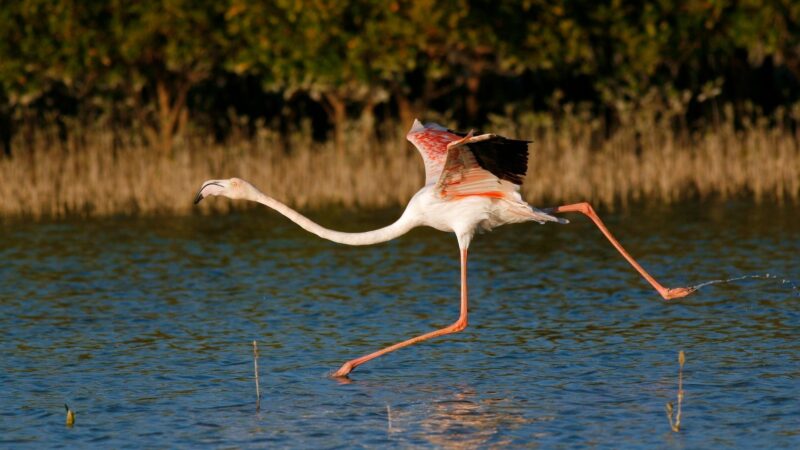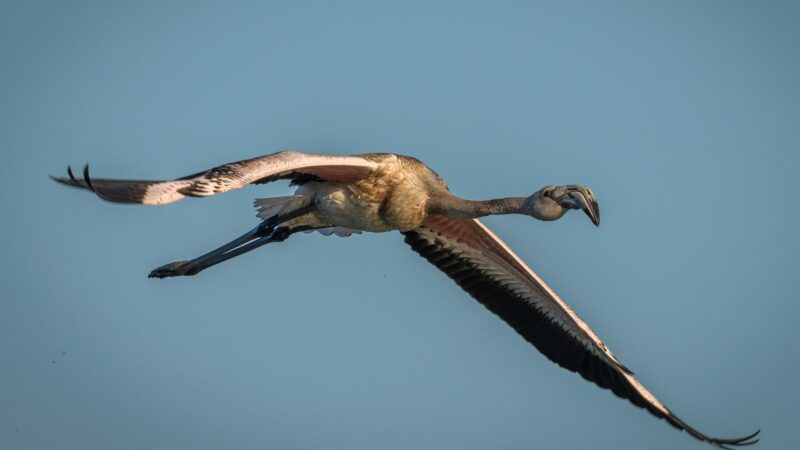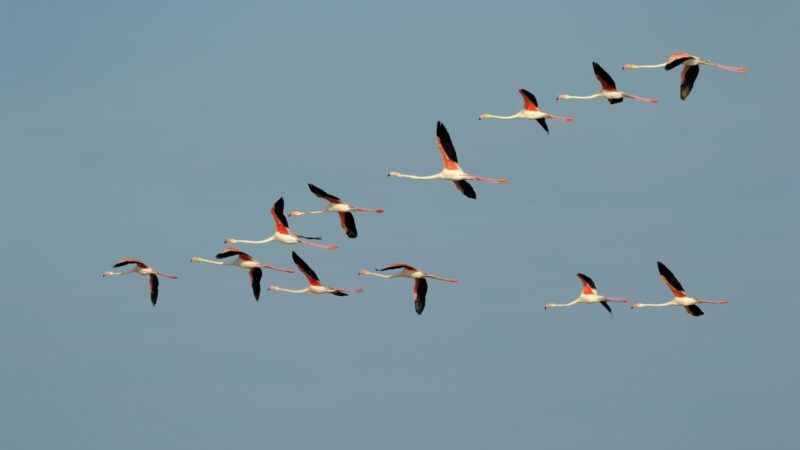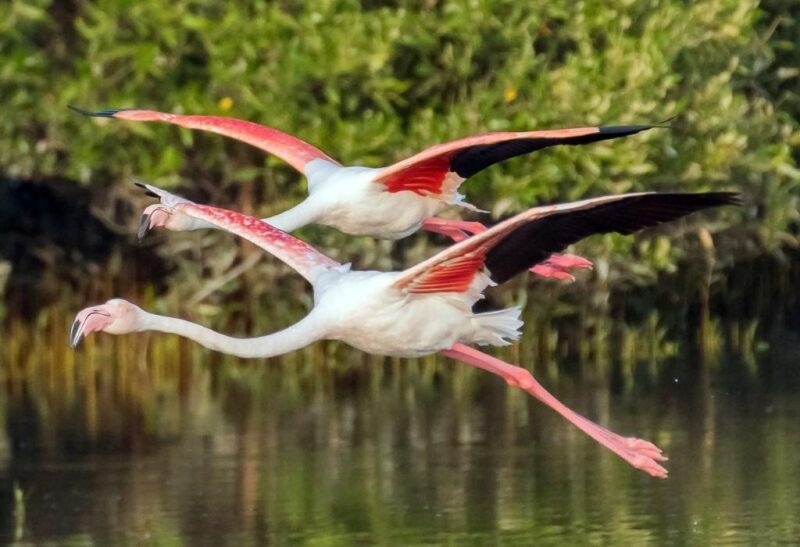Flamingos are interesting creatures with long, stilt-like legs and knees that look like they’re bent backward (they’re not) and S-shaped necks. They are an unusual type of wading bird due to their bright pink-colored feathers and relatively larger body proportions. One has to wonder whether they can fly like most birds.
Despite their size, flamingos can fly and even travel long distances to look for food, breed, or migrate to other bodies of water or warmer areas as seasons change.
In below text read more about how and when flamingos fly, at what age they learn the process of flying, how they fly with other flamingos, and other interesting information about their behavior.
Table of Contents
What Age Do Flamingos Learn to Fly?

Flamingos learn how to fly at 13 to 16 weeks of age. However, some chicks may start developing flight skills earlier, at around 9 to 12 weeks.
This study categorizes flamingo chicks by their flying and foraging ability which are summarized in the table below:
| Age | Flying and Foraging Ability of Flamingos |
| 1 to 6 weeks | Chicks are not able to fly yet and they’re being fed by their parents. |
| 7 to 12 weeks | Chicks may source food themselves but are still not able to fly. |
| 13 to 16 weeks | Chicks may fly short distances and can now forage for themselves. |
| 16 weeks and older | Chicks are now fully able to fly and forage. |
Flamingo parents do not involve themselves in teaching their chicks how to fly, but they make sure they’re well fed in their first months after birth.
How High Can Flamingos Fly?
The flight altitude of flamingos depends on the location (sea or ground), direction, and how strong the wind blows. In the presence of tailwinds, flamingos can fly relatively high.
On the other hand, when the direction of the wind blows in front of them, they are inclined to fly low over water surfaces where the strength of the wind is weaker.
For example, Greater flamingos were seen leaving France flying at a maximum height of 820 feet (250 meters), while those flamingos arriving from the south of the Mediterranean fly at less than 164 feet (50 meters) above the sea.
How Do Flamingos Take Off?

Flamingos have ideal physiologies for flying: wide wingspans that average around 59 inches (1.5 meters), feathers that are initially gray in color and turn pink as they age, and hollow bones.
Typically, they will first run far enough on land or shallow waters to gather wind and create a lift beneath and over their wings. When the wind is strong enough, they can take off directly with a single wing beat. When traveling short distances, flamingos would sometimes glide over land or water.
Flamingos are more active at nighttime. Thus, they also travel at night when they’re planning to go to long-distance destinations, especially when the sky is clear and the winds are ideal.
How Do Flamingos Land?
They land by touching down on the ground or gliding over the water. Then, they run to slow down before skidding to a full stop.
Why Don’t Flamingos Fly Away at the Zoo?
This is because zookeepers or professionals surgically clip flamingo wings as a common practice before holding them in captivity and preventing them from flying away.
An operations manager at Dublin Zoo explains that feather clipping is accepted as it is reversible, meaning their flight feathers would usually grow back. Feather clipping is usually done once a year. It is a painless procedure, causing no harm to the flamingos, and is said to be similar to getting a haircut, according to a bird curator.
Do Flamingos Fly in Flocks?

Flamingos are naturally social creatures that live in large flocks, which can consist of a thousand individual birds. Flocks are usually a mixture of both adults and young flamingos. They group themselves mainly as a defense mechanism against predators.
Usually, flamingo flocks are composed of 500 to 1,000 birds but can exceed that. In fact, Chilean flamingos are grouped in flocks that are equal to almost 20,000 birds.
As such, flamingos generally travel as a flock too. During the flight, the flamboyance of flamingos honking loudly is similar to geese’s behavior. They also make grunting and howling sounds.
How Far Can Flamingos Fly?
While flamingos prefer shorter ranges, they can fly up to a little over 700 miles depending on the species and their location.
- James’ flamingos have no exact reported distance measurements, but they travel 15,978 ft (4,870 m) above sea level during breeding seasons and 7,546 ft (2,300 m) above sea level during non-breeding seasons.
- Greater flamingos were reported to travel a range between 341 miles (550 km) to 708 miles (1,139 km).
- Andean flamingos can travel even longer distances compared to other species at a range of 249 miles (400 km) to 715 miles (1,150 km) daily.
- Caribbean flamingos are known to travel 311 miles (192 km) to 232 miles (373 km) a night.
- Lesser flamingos can travel as far as 280 miles a day (450 km) and have no home ranges because they are nomadic flamingo species.
- Chilean flamingos have no reported flight ranges, but it’s assumed that they also travel hundreds of miles like other flamingo species.
How Fast Can Flamingos Fly?

The average flight speed for flamingos is 31 to 37 miles per hour for short flights and up to 56 miles per hour for longer flights if the winds are favorable. They can maintain speed and fly non-stop or take two or more long continuous trips to reach their destinations.
Do Flamingos Fly in V Formation?
Flamingos tend to travel in aligned rows or in skeins (V-shaped formations) to save energy. While in formation, they communicate by vocalizing loudly to disseminate traveling instructions between individuals.
What Is the Flying Position of Flamingo?

During the flight, their feet and necks are fully extended. The central part of their bodies motions up and down to maintain their head position throughout their journey.
Why Do Flamingos Fly? Why Don’t They Just Stick Around?
Flamingos fly during breeding seasons to find places where they can build nests and stay during incubation and chick-rearing. They also travel periodically from breeding to non-breeding areas. They are not normally migratory birds, but as seasons change, they tend to move to warmer areas at lower altitudes.
James’ flamingos and Andean flamingos stay in salt lakes to breed during the summer and then move to wetlands found in lower elevations during winters. Greater flamingos tend to migrate when their habitats decrease in quality (e.g. water availability, forage scarcity) and other local environmental changes.
Frequently Asked Questions
Can Flamingos Drink Boiling Water?
Flamingos can drink water that is near boiling temperature. Since most flamingos prefer to live near saline lakes where water is often sourced from hot springs flowing into lakes, flamingos will drink hot water with a minimum temperature of 35°C.
How Long Can Flamingos Live?
Flamingos generally live long lives and are known to have one of the longest lifespans among bird species. They have average ages of 25 to 35 years when they live in the wild. This may even be increased to up to 70 years when held captive in zoos.
How Do Flamingos Sleep?
Flamingos can sleep both standing up or lying down. When standing up, they either sleep with their heads firmly tucked on their backs, or they balance on one leg and alternatively shift between legs until they fully wake up—or both.
When lying down to sleep, they fold both legs underneath their bodies or ease one leg towards their feathers.
Although scientists haven’t reached a consensus on the reason why they sleep while standing on one leg, it may be due to keeping their brains awake while sleeping, camouflaging against predators and prey, conserving energy, or thermoregulation.
Do Flamingos Lay Eggs?
Flamingos lay eggs. They typically lay only one large egg, but two eggs are also possible. They take around 28 to 32 days to mature and hatch into chicks.
Flamingos will choose a location for breeding, usually near freshwater bodies. Then, they select another place to lay the eggs and build nest mounds about 6 weeks before the eggs hatch.
Can Flamingos Be Blue?
Flamingos cannot be blue. When flamingo chicks are born, they are varying shades of gray to white. As they age, they turn pink due to the food they eat.
Their diets usually consist of crustaceans and plants, which have carotenoids that are responsible for their red, orange, or yellow coloration. When ingested, it blends with the skin and feathers of flamingos, causing them to turn pinkish.
Flamingos who eat a lot of carotenoid-rich food will be darker pink in color, and those that don’t will be paler.
Summary
Flamingos are birds that can fly long distances. Most of them learn to fly at around 13 to 16 weeks. They fly in flocks and maintain a V-shaped formation.
They take off the ground or water by running and gaining enough speed and wind for their wings. As they fly, their necks and feet are fully stretched. Flamingos fly to migrate or find suitable breeding areas.
List of Sources
Béchet, A. (2017). Flight, navigation, dispersal, and migratory behavior. ResearchGate.
Phoenicopterus chilensis. BioWeb – University of Wisconsin System.
Snyder, N. (2011). Phoenicoparrus jamesi. Animal Diversity Web.
Gibbons, W. (2013). Why Do Flamingos Stand on One Leg? University of Georgia.
Caziani, S. et al. (2007). Seasonal Distribution, Abundance, And Nesting Ofpuna, Andean, And Chilean Flamingos. Academia.
